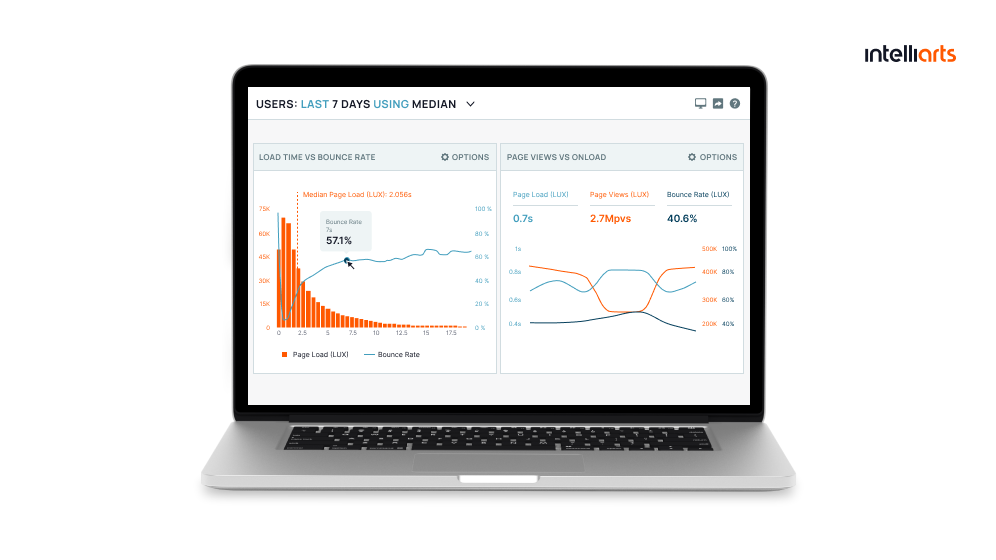Experts expect the total volume of data worldwide to reach 182 zettabytes in 2025, and 394 zettabytes by 2028. This will be fueled by the Internet of Things(IoT) and scalable data processing. What’s the big idea here? Businesses must have the means to gather and utilize the vast amount of data they gather in their operations. In the meantime, scaling and optimizing data pipelines is one of the crucial measures to take in 2025 and beyond.
In every third technology audit, we uncover that big data challenges a particular business experience are actually attributed to poorly optimized data pipelines in place. No wonder we have to emphasize the data pipeline importance that often. — Alexander Barinov, a Managing Partner at Intelliarts
This post will delve into the reasons behind data pipeline scaling. Moreover, you’ll review top data pipeline best practices and techniques, as well as familiarize yourself with tools and technologies. Besides, you will explore future trends in data pipeline optimization techniques and common challenges.
Why businesses scale data pipelines
Businesses have to scale their data pipelines to handle the growing volume, variety, and velocity of data. As a quick example, in one of Intelliarts’ success stories, we helped the customer grow to operating clusters with 2000 cores and 3700 GB of RAM. We’ll explore this DDMR case in detail later in the post.
Here are the most common bottlenecks in data pipelines or negative scenarios that indicate the need for scaling:
#1 Slow data ingestion and processing
Legacy systems and monolithic pipelines struggle to keep pace with the continuous inflow of structured and unstructured data. This causes delays in availability for reporting, analytics, and machine learning.
#2 Failures during peak loads
Sudden increases in data volume — due to seasonal traffic, product launches, or system events — often exceed system capacity, resulting in dropped records, stalled workflows, or pipeline crashes.
#3 Rising cloud costs from inefficient data workflows
Unoptimized workflows that duplicate processing, overuse computing, or retain unnecessary intermediate data lead to uncontrolled cost increases as data volumes scale.
To support this claim, let’s review statistics: More than 78% of organizations estimate that 21-50% of their cloud spend is wasted, highlighting significant inefficiencies in cloud resource utilization.
#4 Inconsistent data quality across sources
Discrepancies in formats, missing values, and outdated or duplicated records lead to unreliable analytics and decision-making. Manual correction slows delivery and increases the risk of errors.
#5 Pipeline observability and debugging limitations
Lack of visibility into pipeline stages and transformations makes it difficult to detect issues, trace data lineage, or identify the source of data integrity problems.
#6 Difficulty adapting pipelines to new business needs
Hardcoded dependencies, schema rigidity, and fragmented tools prevent teams from responding quickly to new data sources, compliance changes, or evolving business questions.
Statistics reveal that 64% of customers wish companies would adapt more quickly to their changing needs, underscoring the necessity for flexible and responsive data pipelines.
In response to the drawbacks of not scaling data pipelines, let’s take a look at the actual benefits of having scalable data processing in place. The list is provided in the infographic below to support effective data presentation:
Best practices for data pipeline optimization
Let’s proceed with reviewing data pipeline best practices complemented with tech stack suggestions and highlights of potential business gains:
#1 Stick to parallel processing
Parallel processing involves distributing large datasets or compute-intensive tasks across multiple cores or nodes so that they are processed simultaneously rather than sequentially. This approach maximizes hardware utilization and reduces bottlenecks in data-heavy operations like ETL, machine learning model training, and large-scale aggregations.
Tools: Apache Spark, Dask, Ray
Business gain:
- Reduced time-to-insight for analytics and decision-making
- Support for real-time data products
- Improved overall system throughput
#2 Use means of efficient storage and retrieval
Efficient data storage focuses on minimizing latency and cost by using columnar file formats, data compression, partitioning, and tiered storage strategies. It also includes indexing and metadata optimization to speed up query response times and reduce input/output (I/O) operations during access.
Tools: Apache Parquet, Delta Lake, Amazon S3 (with Intelligent-Tiering), Google BigQuery
Business gain:
- Reduced long-term storage costs
- Accelerated data queries and dashboard loads
- Ensured scalability as data volume grows
#3 Utilize automated scaling
Automated scaling allows infrastructure resources — compute, memory, and storage — to expand or shrink based on real-time workload demands. This elasticity ensures that the system can handle unexpected data spikes without over-provisioning or underutilizing resources.
Tools: Kubernetes, AWS Auto Scaling, Google Cloud Dataflow, Azure Data Factory
Business gain:
- Reduced infrastructure costs by avoiding manual provisioning
- Ensured operational stability during load surges
- Improved SLAs for data availability
#4 Implement data caching
Caching involves storing frequently accessed data in-memory or closer to the compute layer to reduce retrieval times and lower the load on primary data stores. This is especially valuable in repetitive query workloads, API integrations, and real-time applications like recommendation engines.
Tools: Redis, Memcached, Apache Ignite
Business gain:
- Enhanced performance of time-sensitive applications
- Lowered query response latency
- Reduced backend system load
#5 Apply orchestration and monitoring procedures
Pipeline orchestration automates the execution of interdependent data tasks, ensuring they run in the correct order, at the right time, and only when prerequisites are met. Monitoring adds real-time visibility into task status, failures, and performance metrics, enabling proactive management.
Tools: Apache Airflow, Dagster, Prefect, Monte Carlo
Business gain:
- Increased pipeline reliability
- Reduced downtime
- Simplified troubleshooting
- Improved operational efficiency for data engineering teams
#6 Utilize schema enforcement and validation measures
Schema enforcement ensures that incoming data adheres to predefined structural rules before it’s accepted into the pipeline. Validation catches issues like missing fields, type mismatches, or format violations early, preventing them from cascading into analytics or models.
Tools: Apache Avro, Protocol Buffers (Protobuf), Great Expectations, Deequ
Business gain:
- Ensured consistency and trust in data across systems
- Reduced cost of data cleaning
- Protected downstream workflows from silent failures
You may be additionally interested in exploring data pipeline components from our other blog post.
Find the information from this section summarized in the simple infographics below:
Tools and technologies for data pipeline optimization
Choosing the wrong data tooling — whether due to poor fit for scale, lack of integrations, or complexity — can lead to the following negative outcomes:
- Spiraling infrastructure costs. Extra expenses are a result of over-provisioned resources or inefficient processing.
- Pipeline instability. This is typically caused by tools not built for high-volume or low-latency use cases.
- Longer development cycles. This challenge results from teams struggling with configuration, compatibility, or debugging.
- Poor data quality and loss of trust. Such issue often arises in analytics procedures, and it’s caused by undetected failures.
Have a project idea? Don’t hesitate to request our software engineering services.
Now let’s take a scope of pipeline optimization procedures and find out what tools and technologies can serve better in each case:
5 common data pipeline scaling challenges and how to overcome them
It’s fairly often when businesses that are looking to fix data pipeline observability face technical and business issues. Let’s take a look at the most common of them and find out what data scientists at Intelliarts have to advise:
#1 Linear scaling with growing data volume
When pipelines scale linearly with data size, organizations often find themselves adding compute resources without meaningful gains in efficiency. This creates cost pressure and limits responsiveness to data growth.
Solution: It’s advisable to redesign the pipeline architecture around horizontally scalable components. Distributed processing frameworks can help, and it may also be worth revisiting workload segmentation strategies.
#2 High cloud costs due to uncontrolled scaling
Unplanned or reactive scaling often leads to overprovisioned computing, redundant processing, and ballooning storage usage — costs that are hard to trace until it’s too late.
Solution: We suggest implementing cost observability across the pipeline and optimizing data storage formats. In many cases, moving to event-driven or serverless designs also helps reduce idle resource consumption.
#3 Slow onboarding of new data sources
Manual integration of new data sources — especially with inconsistent formats or contracts — can delay analytics and product timelines. This is particularly problematic in fast-moving markets.
Solution: It’s worth adopting schema-driven ingestion patterns and building reusable connectors. We can also recommend a contract-first approach to data collaboration between teams or vendors.
#4 Fragmented tooling across teams
A lack of standardization in pipeline tooling often leads to duplicated work, inconsistent practices, and operational silos that hinder innovation at scale.
Solution: Standardizing core tools and workflows — while still allowing some local flexibility — can make scaling smoother. Cross-functional alignment sessions or platform enablement programs are often helpful here.
#5 Lack of visibility into scaled pipelines
As complexity grows, pipeline failures or data quality issues become harder to detect and resolve, which can undermine trust in data systems.
Solution: It’s advisable to embed observability from the start: centralized logging, pipeline health dashboards, and data lineage tracking are all essential. If this hasn’t been done yet, an internal audit is a good first step.
Explore real estate infrastructure optimization in another blog post by Intelliarts for extra insight into ways to resolve actual business challenges.
And here’s the summary of challenges from this section:
Success story: Real business gains through data pipeline optimization
In one of Intelliarts’ success stories, we assisted DDMR, a US-based data-driven market research company, with optimizing a data pipeline. Here’s how the case unfolded:
Challenge:
DDMR’s data pipeline was fragmented, browser-dependent, and difficult to scale. Data collection was limited to Firefox, storage lacked tiering, transformation was handled by legacy Java/Hadoop stacks, and infrastructure was prone to manual errors. The company struggled with cost efficiency, slow processing, and compliance risks — all while trying to grow its data-driven business.
Solution:
Intelliarts provided information technology consulting and built a full-cycle, scalable data pipeline covering ingestion, processing, storage, and delivery. We replaced the browser-specific collector with a platform-agnostic solution, introduced hot vs. cold storage, modernized the processing stack (moving from Hadoop to Spark and later Snowflake + DBT + Airflow), automated infrastructure via Terraform and Ansible, and integrated GDPR-compliant data handling and monitoring.
Curious about the engineering perspective of creating scalable data pipelines? Examine the entire step-by-step process of building a big data pipeline for DDMR in another blog post by Intelliarts.
Results:
- Multi-browser data acquisition expanded reach
- Reduced storage costs via tiered architecture
- 5x+ revenue growth due to improved scalability
- 24/7 monitoring and auto-recovery mechanisms enabled high availability
- New value-added products opened fintech and analytics markets
- Full technical ownership transferred to Intelliarts, freeing internal teams to focus on growth
Future data pipeline optimization trends or how to not fall behind the competition
Finally, here’s an insight into what businesses should expect to become a must-have in the data engineering niche:
#1 Data-aware auto-scaling using ML-based workload forecasting
Most current auto-scaling logic reacts to thresholds (e.g., CPU or memory use), but experimental approaches now involve machine learning models that predict workload surges and preemptively scale infrastructure. This aims to reduce cold starts and ensures smoother performance during traffic bursts.
- Early application: Google’s Borg scheduler and Kubernetes’ KEDA with Prometheus integrations.
Additionally, check the delivery optimization consulting success story by Intelliarts.
#2 AI-assisted pipeline observability and incident resolution
Beyond static monitoring, some companies are piloting AI copilots that automatically trace root causes across logs, metrics, and traces. These copilots integrate with observability tools to offer proactive resolution recommendations or even auto-remediation scripts.
- Early adoption: Microsoft’s DevCopilot prototype, IBM’s AIOps Research.
#3 Differential data processing or compute-on-change concept
Instead of reprocessing entire datasets, differential or incremental processing re-runs pipelines only for data that has changed. This reduces compute usage drastically, especially in CDC (change data capture) scenarios and ML feature pipelines.
- Experiment usage: dbt with incremental models, Delta Live Tables (Databricks), and experimental PostgreSQL triggers + Apache Beam.
Data pipeline optimization innovations are hardly popular news. However, engineers and representatives of technology-first companies should keep up with such trends to be competitive in this incredible data-centric business environment.
Need assistance with data pipeline optimization? Don’t hesitate to request data engineering services by Intelliarts.
Final take
In 2025, businesses must scale data pipelines to manage growing data volume, ensure reliability, and control cloud costs. Key practices include parallel processing, automated scaling, schema enforcement, and efficient storage. Choosing the right tools and standardizing workflows helps prevent fragmentation and maintain data quality. Looking ahead, AI-assisted observability and differential processing will define the next wave of pipeline efficiency and agility in a data-driven world.
The Intelliarts team has more than 24 years of experience in software engineering and 80+ large projects under our belt. Combined with a business-oriented approach and a 90% customer retention rate, we positioned ourselves as one of the best data engineering companies in the market. Should you need an expert team to cover your scalable data processing needs, don’t hesitate to reach out to Intelliarts.
FAQ
1. How do I choose the right tools for my data pipeline?
Start by evaluating your data volume, processing frequency, integration needs, and team expertise. Choose tools that align with your existing stack and support pipeline optimization techniques. Look for solutions with strong community support, good documentation, and proven scalability.
2. What are the main 3 stages in a data pipeline?
A standard pipeline includes data ingestion, transformation, and loading (ETL/ELT). Each stage must be designed to support data pipeline optimization through efficient processing, robust error handling, and scalable architecture.
3. What are the key considerations when designing a data pipeline for scalability?
Focus on modular architecture, stateless processing, and asynchronous workloads. Use distributed systems and cloud-native tools that allow scalable data pipelines to grow with demand. Prioritize automation, observability, and failure recovery mechanisms.
















